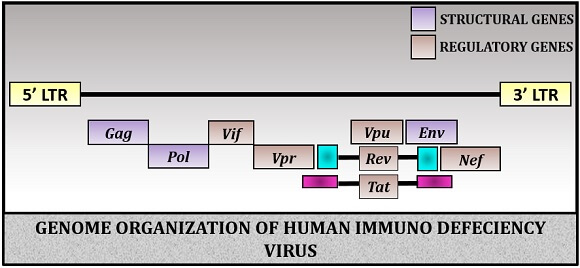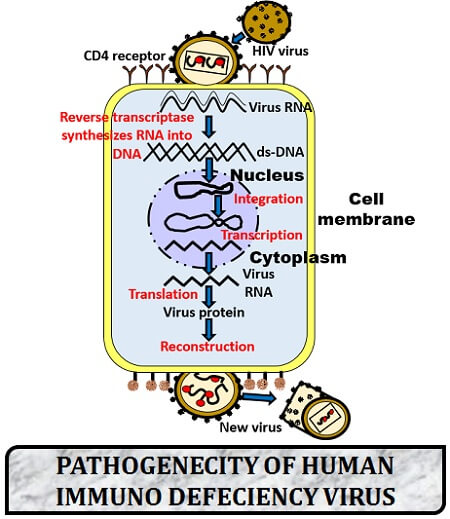HIV stands for Human Immuno Deficiency Virus. It belongs to the group of Retrovirus, which consist of positive single-stranded RNA. HIV was first isolated from the patient’s lymph node by Montagnier and Barre Sinoussi who won Nobel prize in the year 2008. The symmetry of HIV is icosahedral. Human Immuno Deficiency virus is enveloped and diploid.
HIV belongs to the family Retroviridae and genus Lentivirus. It is a lethal virus that can cause life long effects by damaging the immunogenic cells like T-cells, macrophages, dendritic cells. Among the immunogenic cells, the mainly affected cells by the Human Immuno Deficiency virus is CD4 cells.
Human Immuno Deficiency virus damages the immune system by successive damage to the CD4 cells. HIV is a lentivirus which means “Slow virus” which takes time to make someone sick, and it infects the cell in three stages, namely acute stage, chronic latency stage and AIDs. There is a long interval between the primary infection and onset of AIDs. In this context, we will discuss the meaning, structure, genome organization and the life cycle of HIV.
Content: HIV
Meaning of HIV
Human Immunodeficiency virus is defined as a foreign body, which weakens the immune system by damaging the CD4 cells (a type of effector T-cells) that protects the body against the antigens and can induce various types of infections and diseases. The initial stage of HIV cause acute infection, later it causes chronic infection and eventually leads to AIDs. HIV is thought to be evolved from the chimpanzees in Central Africa infected with simian immunodeficiency virus (SIV).
Structure of HIV
Human immunodeficiency virus is a retrovirus containing RNA as genetic material and possesses a very complex structure.

- Outer envelope: The outer layer consists of lipid bilayer membrane that surrounds the matrix, protein capsid and the core material of the virus. It is embedded with many host cell proteins during the process of budding.
- Nucleocapsid: The shape of the nucleocapsid is cone-shaped. The nucleocapsid is very dense and composed of 2,000 copies of the viral protein p24.
- Matrix: It comprises of p17 viral proteins and encases the nucleocapsid.
- Genetic material: The genetic material of HIV contains two copies RNA as genetic material. The RNA of HIV is positive-stranded. It is tightly bound with the reverse transcriptase, integrase, ribonuclease and protease enzymes that perform different functions at different viral infection stages.
- Spikes: These are the filament-like structures originated from an envelope through the ENV-enzyme. The spikes possess a cap composed of three molecules of gp120 and three molecules of gp41.
Genome Organization of HIV
The genome size of HIV is 9.8 Kb. There are three structural and six regulatory genes found in the genome of HIV.

Structural Genes
The primary function of HIV is to perform the structural synthesis of new viruses. There are three structural genes, namely Gag, Env and Pol.
- Gag: It stands for group-specific antigen and consists of p-7, p-17 and p-24 enzymes.
- Env: It stands for envelope consisting of gp-160 proteins that break down into gp-120 and gp-41. Therefore, there are two subtypes of Env that is gp-120 and gp-41. Gp-120 is the extracellular protein, which helps in binding of the virion with CD4 cells. Gp-41 is the transmembrane protein that helps in the fusion of cellular and viral membranes.
- Pol: It stands for polymerase, which includes reverse transcriptase, integrase and protease enzymes.
Regulatory Genes
Six regulatory genes regulate many functions at the time of host infection like replication, biosynthesis, virulence factors etc. Out of six regulatory genes, two (Tat and Rev) are involved in RNA replication. Apart from Tat and Rev genes, others are involved in biosynthesis, virus release etc.
- Tat: It helps in the transcription of the retroviral RNA.
- Rev: It helps in the transportation of the late mRNAs from the nucleus to the cytoplasm.
- Nef: It decreases the expression of CD4 cells.
- Vif: It enhances virulence.
- Vpr: Transports the viral core from the cytoplasm to nucleus.
- Vpu: It enhances the virion release from the cell.
Life Cycle of HIV
The pathogenicity of HIV includes the following steps:

Recognition of appropriate receptors: When HIV enters our body. It first recognizes the receptors and coreceptors present on the cell surface of CD4 T-cells. CCR-5 and CXCR-4 are the receptor and coreceptor, respectively, present on the cell surface of CD4 cells. Therefore, the gp-120 and gp-41 proteins of the virion will contact the CD4 cell’s cell receptors.
Attachment: After the recognition of specific binding sites, the gp-120 binds with the CD4 receptors. It promotes further binding with the co-receptor.
Conformational change: The binding of gp-120 to the receptor proteins creates a conformational change in the gp-120. As a result, gp-41 unfolds, and it inserts its hydrophobic terminus on the host cell surface.
Fusion: The gp-41 then folds back on itself and draws the virus towards the cell and results in the fusion of two membranes, i.e. virus envelope and cell membrane of the CD4 cell.
Uncoating: This stage is also called insertion or penetration. After the virus and host cell membrane’s fusion, the viral nucleocapsid enters the host cell cytoplasm. The nucleocapsid contains RNA strands and three essential replication enzymes, namely restriction enzyme, integrase and protease.
Reverse transcription: It is the process of conversion of viral RNA into DNA by the reverse transcriptase. The reverse transcriptase enzyme contains two catalytic domain, namely ribonuclease H-active site and polymerase active site. From polymerase active site, the ss-RNA transcribes into RNA-DNA double helix. Then, the ribonuclease H-active site breaks down the RNA.
Replication: After that, the polymerase active site completes the ss-DNA by the polymerization activity and forms a complementary strand of DNA to form a ds-DNA helix.
Integration: In this step, the viral ds-DNA enters the host cell genome through the integrase enzyme. Integrase comes into the action and cleaves a di-nucleotide from DNA 3’ end by producing sticky ends. The integrase enzyme then transfers the DNA to the cell nuclease and facilitates the integration of viral DNA into the host cell genome. This process occurs inside the nucleus of the host cell.
Transcription: A cell then contains a viral DNA, which further undergoes transcription to form m-RNA. This m-RNA then moves from nucleus to the cytoplasm of the cell.
Translation: The m-RNA translates to synthesize the building blocks or viral proteins for the new virus.
Processing: It involves the processing of viral proteins by the protease, which cleaves the longer proteins to the smaller core proteins.
Reconstruction: At this stage, the RNA strands, reverse transcriptase, integrase and protease enzymes come together, and the core protein surrounds the capsid.
Budding: The mature virus particle releases out of the cell through the process of budding, which acquires a new envelope of viral protein. The virus infects the other cells.
HIV replicates billion of times by affecting the CD4 cells and progressively damages the immune system by making a person prone to many infections.
You are sharing the best blog and its very informative.